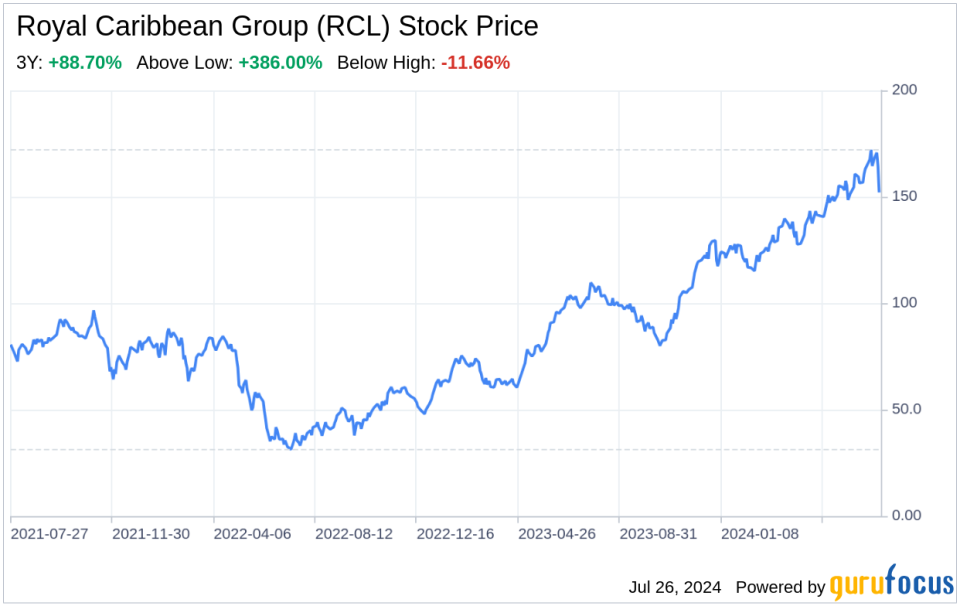Decoding Royal Caribbean Group (RCL): A Strategic SWOT Insight
Robust revenue growth with a significant increase in net income year-over-year.
Continued expansion with a strong pipeline of new ships on order.
Strategic investments in joint ventures to bolster market presence.
Market risks and legal proceedings pose potential threats to financial stability.
On July 25, 2024, Royal Caribbean Group (NYSE:RCL), the world's second-largest cruise company, filed its 10-Q report, revealing a detailed financial snapshot of its operations. The company, known for its innovative and high-quality cruise experiences, operates a fleet of 65 ships with eight more on order. Royal Caribbean Group's diverse brand portfolio includes Royal Caribbean International, Celebrity Cruises, and Silversea, along with a 50% investment in a joint venture operating TUI Cruises and Hapag-Lloyd Cruises. The latest financial tables from the 10-Q filing indicate a year-over-year increase in total revenues from $3,523 million to $4,110 million for the quarter ended June 30, 2024. Net income attributable to Royal Caribbean Cruises Ltd. also saw a substantial rise from $459 million to $854 million, reflecting a strong financial performance. This SWOT analysis will delve into the strengths, weaknesses, opportunities, and threats as disclosed in the 10-Q filing, providing investors with a comprehensive understanding of Royal Caribbean Group's strategic and financial position.

Strengths
Financial Performance and Brand Portfolio: Royal Caribbean Group's financial health has shown remarkable improvement, with a notable increase in net income from $459 million in 2023 to $854 million in 2024 for the same quarter. This financial robustness is underpinned by a diversified brand portfolio that caters to various market segments, allowing the company to leverage cross-brand synergies and mitigate risks associated with market fluctuations. The strength of its brand portfolio is evident in the increased passenger ticket revenues, which climbed from $2,444 million to $2,887 million year-over-year, demonstrating the brands' ability to attract and retain customers.
Innovative Offerings and Fleet Expansion: Royal Caribbean Group's commitment to innovation and fleet expansion is a significant strength. The company's investment in new ships and the modernization of existing ones ensures that it remains at the forefront of the cruise industry. With eight new ships on order, the company is poised to capture increased market share and meet the growing demand for cruise vacations. This strategic expansion is supported by a strong balance sheet, which is crucial for funding new initiatives and sustaining growth.
Weaknesses
Operational Costs and Debt: Despite robust revenue growth, Royal Caribbean Group faces challenges in managing its operational costs, which have risen from $1,955 million to $2,152 million year-over-year for the quarter. The increase in costs, particularly in payroll and related expenses, food, and fuel, can impact profit margins if not effectively controlled. Additionally, the company's debt levels, with a net interest expense of $298 million, remain a concern as they may limit financial flexibility and increase vulnerability to economic downturns.
Market Risks and Legal Proceedings: The company's exposure to market risks, such as fluctuations in fuel prices and currency exchange rates, can adversely affect its financial performance. Furthermore, ongoing legal proceedings, like the lawsuit filed under the Helms-Burton Act, which resulted in a judgment against the company, highlight potential financial liabilities that could impact its bottom line and reputation.
Opportunities
Global Market Expansion: Royal Caribbean Group has the opportunity to further expand its global footprint, especially in emerging markets where the demand for cruise vacations is growing. Strategic partnerships and joint ventures, such as those with TUI Cruises and Hapag-Lloyd Cruises, provide avenues for growth and access to new customer segments. By leveraging its strong brand presence and diversified offerings, the company can capitalize on these emerging opportunities to drive revenue growth.
Technological Advancements: The integration of advanced technologies in operations and customer service can enhance the cruise experience and operational efficiency. Royal Caribbean Group can leverage data analytics, artificial intelligence, and other digital tools to personalize guest experiences, optimize route planning, and improve energy efficiency, thereby reducing costs and enhancing customer satisfaction.
Threats
Competitive Industry Landscape: The cruise industry is highly competitive, with several major players vying for market share. Intense competition can lead to price wars, which may erode profitability. Royal Caribbean Group must continue to innovate and differentiate its offerings to maintain a competitive edge and attract customers in this challenging environment.
Geopolitical and Economic Uncertainties: Geopolitical tensions and economic uncertainties can impact consumer spending and travel patterns, posing a threat to the cruise industry. Royal Caribbean Group must navigate these challenges by adopting flexible business strategies and maintaining a strong financial reserve to withstand potential downturns.
In conclusion, Royal Caribbean Group (NYSE:RCL) has demonstrated strong financial performance and brand strength in its latest 10-Q filing. The company's strategic investments in fleet expansion and innovative offerings position it well for future growth. However, it must address operational cost management and debt levels to maintain financial health. Opportunities for global expansion and technological advancements present avenues for further success, while competitive pressures and external uncertainties require vigilant strategic planning. Overall, Royal Caribbean Group's strategic initiatives and robust financial results indicate a positive outlook, with careful attention needed to mitigate potential threats.
This article, generated by GuruFocus, is designed to provide general insights and is not tailored financial advice. Our commentary is rooted in historical data and analyst projections, utilizing an impartial methodology, and is not intended to serve as specific investment guidance. It does not formulate a recommendation to purchase or divest any stock and does not consider individual investment objectives or financial circumstances. Our objective is to deliver long-term, fundamental data-driven analysis. Be aware that our analysis might not incorporate the most recent, price-sensitive company announcements or qualitative information. GuruFocus holds no position in the stocks mentioned herein.
This article first appeared on GuruFocus.
